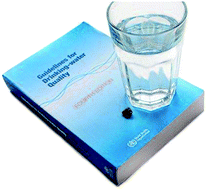World Health Organization increases its drinking-water guideline for uranium†
Abstract
The World Health Organization (WHO) released the fourth edition of Guidelines for Drinking-

* Corresponding authors
a
Department of Chemistry and Biochemistry, Norwich University, Northfield, VT, USA
E-mail:
sfrisbie@norwich.edu, emitchel@student.norwich.edu
b
Department of Molecular Structure and Function, The Research Institute of The Hospital for Sick Children and Department of Biochemistry, University of Toronto, Toronto, Ontario, Canada
E-mail:
bsarkar@sickkids.ca
Fax: +1-416-813-5379
Tel: +1-416-813-5921
The World Health Organization (WHO) released the fourth edition of Guidelines for Drinking-

 Please wait while we load your content...
Something went wrong. Try again?
Please wait while we load your content...
Something went wrong. Try again?
S. H. Frisbie, E. J. Mitchell and B. Sarkar, Environ. Sci.: Processes Impacts, 2013, 15, 1817 DOI: 10.1039/C3EM00381G
To request permission to reproduce material from this article, please go to the Copyright Clearance Center request page.
If you are an author contributing to an RSC publication, you do not need to request permission provided correct acknowledgement is given.
If you are the author of this article, you do not need to request permission to reproduce figures and diagrams provided correct acknowledgement is given. If you want to reproduce the whole article in a third-party publication (excluding your thesis/dissertation for which permission is not required) please go to the Copyright Clearance Center request page.
Read more about how to correctly acknowledge RSC content.
 Fetching data from CrossRef.
Fetching data from CrossRef.
This may take some time to load.
Loading related content
